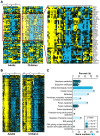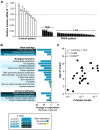Altered gene expression and DNA damage in peripheral blood cells from Friedreich's ataxia patients: cellular model of pathology
- PMID: 20090835
- PMCID: PMC2799513
- DOI: 10.1371/journal.pgen.1000812
Altered gene expression and DNA damage in peripheral blood cells from Friedreich's ataxia patients: cellular model of pathology
Abstract
The neurodegenerative disease Friedreich's ataxia (FRDA) is the most common autosomal-recessively inherited ataxia and is caused by a GAA triplet repeat expansion in the first intron of the frataxin gene. In this disease, transcription of frataxin, a mitochondrial protein involved in iron homeostasis, is impaired, resulting in a significant reduction in mRNA and protein levels. Global gene expression analysis was performed in peripheral blood samples from FRDA patients as compared to controls, which suggested altered expression patterns pertaining to genotoxic stress. We then confirmed the presence of genotoxic DNA damage by using a gene-specific quantitative PCR assay and discovered an increase in both mitochondrial and nuclear DNA damage in the blood of these patients (p<0.0001, respectively). Additionally, frataxin mRNA levels correlated with age of onset of disease and displayed unique sets of gene alterations involved in immune response, oxidative phosphorylation, and protein synthesis. Many of the key pathways observed by transcription profiling were downregulated, and we believe these data suggest that patients with prolonged frataxin deficiency undergo a systemic survival response to chronic genotoxic stress and consequent DNA damage detectable in blood. In conclusion, our results yield insight into the nature and progression of FRDA, as well as possible therapeutic approaches. Furthermore, the identification of potential biomarkers, including the DNA damage found in peripheral blood, may have predictive value in future clinical trials.
Trial registration: ClinicalTrials.gov NCT00229632.
Conflict of interest statement
The authors have declared that no competing interests exist.
Figures





Similar articles
-
Comprehensive analysis of gene expression patterns in Friedreich's ataxia fibroblasts by RNA sequencing reveals altered levels of protein synthesis factors and solute carriers.Dis Model Mech. 2017 Nov 1;10(11):1353-1369. doi: 10.1242/dmm.030536. Dis Model Mech. 2017. PMID: 29125828 Free PMC article.
-
A novel GAA-repeat-expansion-based mouse model of Friedreich's ataxia.Dis Model Mech. 2015 Mar;8(3):225-35. doi: 10.1242/dmm.018952. Epub 2015 Feb 13. Dis Model Mech. 2015. PMID: 25681319 Free PMC article.
-
Friedreich's ataxia: clinical aspects and pathogenesis.Semin Neurol. 1999;19(3):311-21. doi: 10.1055/s-2008-1040847. Semin Neurol. 1999. PMID: 12194387 Review.
-
A combined nucleic acid and protein analysis in Friedreich ataxia: implications for diagnosis, pathogenesis and clinical trial design.PLoS One. 2011 Mar 11;6(3):e17627. doi: 10.1371/journal.pone.0017627. PLoS One. 2011. PMID: 21412413 Free PMC article.
-
Friedreich's ataxia: pathology, pathogenesis, and molecular genetics.J Neurol Sci. 2011 Apr 15;303(1-2):1-12. doi: 10.1016/j.jns.2011.01.010. J Neurol Sci. 2011. PMID: 21315377 Free PMC article. Review.
Cited by
-
A gene expression phenotype in lymphocytes from Friedreich ataxia patients.Ann Neurol. 2011 Nov;70(5):790-804. doi: 10.1002/ana.22526. Ann Neurol. 2011. PMID: 22162061 Free PMC article.
-
Gene expression profiling to identify the toxicities and potentially relevant disease outcomes due to endosulfan exposure.Toxicol Res (Camb). 2016 Jan 22;5(2):621-632. doi: 10.1039/c5tx00332f. eCollection 2016 Mar 1. Toxicol Res (Camb). 2016. PMID: 30090376 Free PMC article.
-
DNA repair after oxidative stress: current challenges.Curr Opin Toxicol. 2018 Feb;7:9-16. doi: 10.1016/j.cotox.2017.10.009. Epub 2017 Oct 16. Curr Opin Toxicol. 2018. PMID: 29159324 Free PMC article.
-
Skeletal Muscle Involvement in Friedreich Ataxia.Int J Mol Sci. 2024 Sep 13;25(18):9915. doi: 10.3390/ijms25189915. Int J Mol Sci. 2024. PMID: 39337401 Free PMC article. Review.
-
Pulmonary Arterial Hypertension Is Associated with Oxidative Stress-induced Genome Instability.Am J Respir Crit Care Med. 2015 Jul 15;192(2):129-30. doi: 10.1164/rccm.201505-0904ED. Am J Respir Crit Care Med. 2015. PMID: 26177169 Free PMC article. No abstract available.
References
-
- Campuzano V, Montermini L, Lutz Y, Cova L, Hindelang C, et al. Frataxin is reduced in Friedreich ataxia patients and is associated with mitochondrial membranes. Hum Mol Genet. 1997;6:1771–1780. - PubMed
-
- Campuzano V, Montermini L, Molto MD, Pianese L, Cossee M, et al. Friedreich's ataxia: autosomal recessive disease caused by an intronic GAA triplet repeat expansion. Science. 1996;271:1423–1427. - PubMed
-
- Ohshima K, Montermini L, Wells RD, Pandolfo M. Inhibitory effects of expanded GAA.TTC triplet repeats from intron I of the Friedreich ataxia gene on transcription and replication in vivo. J Biol Chem. 1998;273:14588–14595. - PubMed
-
- Muhlenhoff U, Richhardt N, Ristow M, Kispal G, Lill R. The yeast frataxin homolog Yfh1p plays a specific role in the maturation of cellular Fe/S proteins. Hum Mol Genet. 2002;11:2025–2036. - PubMed
Publication types
MeSH terms
Substances
Associated data
Grants and funding
LinkOut - more resources
Full Text Sources
Other Literature Sources
Medical
Molecular Biology Databases
Miscellaneous

